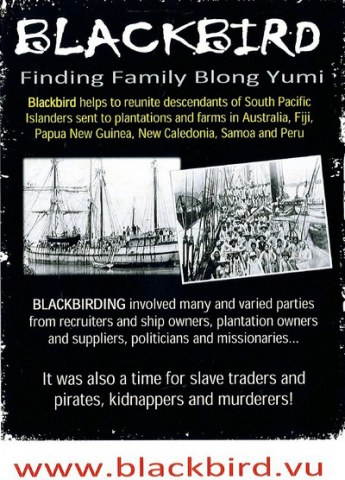Hi everyone,
I have recently become aware that Sonia Minniecon from Mackay is providing free assistance for Australian South Sea Islander people who are trying to trace their family histories.
She is calling the service “Blackbird”. She has travelled to Vanuatu recently and has established relationships with several Chiefs who are facilitating family reunions.
Please circulate her flyer (takes a little while to open).
Regards
Pam
Pamela Britt | Program Officer - Community & Personal Histories | 07 3234 1928 or freecall 1800 650 230| Fax 07 3239 3464 | Aboriginal and Torres Strait Islander Services | Department of Communities
The history of the "trade"
Blackbirding in its most significant form began in Australia with Sydney politician and merchant, Captain Robert Towns who arranged for a sandalwood trader operating from Tanna, Henry Lewin, to recruit islanders from the Loyalty and New Hebrides Groups (Vanuatu) in 1863 for his cotton plantation on the Logan River. However, blackbirding in Australia began with the first acknowledged Blackbirder Captain William Boyd in 1847 when his schooner Velocity landed sixty-five men from the New Hebrides. Peru conducted the most devastating raids in 1862 and 1863.
During Australia's main Blackbirding days between 1863 to 1904 Queensland sugar and cotton plantations, sheep and cattle farms, pearling and fishing vessels and domestic households were worked by South Sea Islanders who were recruited – or more accurately during the Blackbird “era” kidnapped – by men who were, and are still known today as Blackbirders.
Blackbirding in the Pacific region was not only left to Australians. Plantation owners in Fiji, New Caledonia, German plantation owners in Samoa and Papua New Guinea recruited for their respective locations. In 1862 and 1863 Peruvian mine owners organised devastating slave raids on the Pacific.
Over a period of about 40 years, 62,000 Islanders were brought to Queensland from the Solomon Islands, Vanuatu, Papua New Guinea and other parts of the South Pacific to provide cheap labour for the burgeoning sugar industry. A small number of labourers came from the Polynesian and Micronesian islands such as Samoa, Kiribati and Tuvalu.
During this time Fijian plantation owners conducted labour recruiting from Vanuatu, Solomon Islands, Rotuma, Gilbert and Ellice Islands. The German plantation owners in Papua New Guinea and Samoa recruited from the Northern Solomons, Vanuatu and other parts of the Pacific as did the plantations in New Caledonia.
Peruvian mine owners also conducted a series of devastating slave raids which significantly depopulated Easter Island, Cook Islands, Niue, Kirribati, Tuvalu, Samoa, Rotuma, Tonga, the Maquesas and others in just two years between 1862 and 1863.
The fate of these “recruits” is varied and many. From having a successful life in Australia or Fiji with many children and grandchildren, owning a home, a job or a business or being returned to their island after their term to return to Island life. To being returned after a 3 year contract only to be dropped on the wrong island, wrong country or in the worst cases, straight overboard never to be seen again.
For being given a different name by the recruiting agent to that of their custom name and being forever lost in the process unless some slight or useful clue is left on a ship log, old letter or perhaps the name given to their grandchild that can be retraced to a specific village on a specific island in a specific part of the Pacific.
To being killed fleeing a Blackbirder after realising a trap; being lost at sea, murdered or shipwrecked and completely unaccounted for or dying from western diseases, hunger or abuse at the hand of the plantation owner, not to mention the occasional battles with local Aboriginal tribes in Australia.
No matter, there are many that have not found their family, don’t know where they ended up, nor know where they come from.
Today, in many villages throughout Vanuatu, Solomon Islands and other parts of the Pacific, there are individuals and families that have many questions as to what happed to their father, grandfather, uncle and aunty. Did they have children and grandchildren? Did they make the journey? Where did they go? What happened to them?

